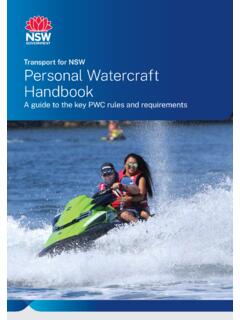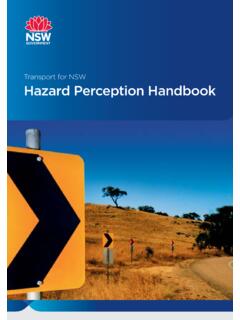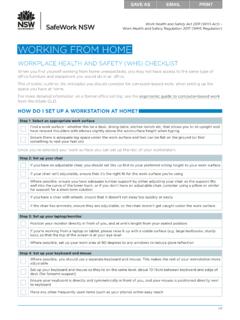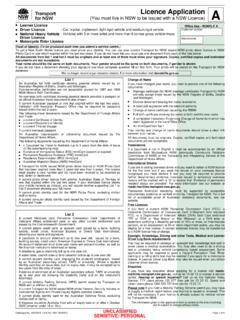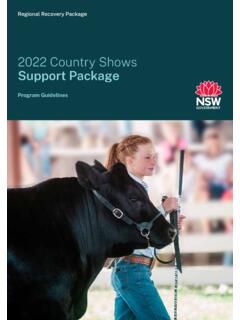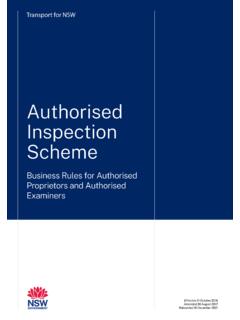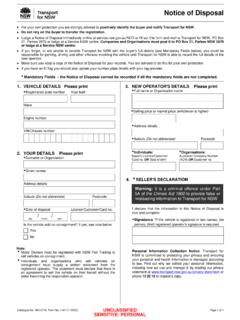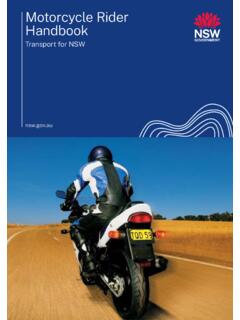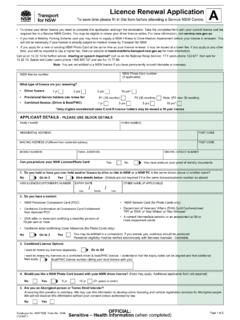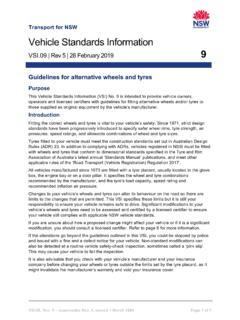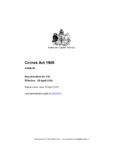Transcription of Transport for NSW Boating Handbook
1 Transport for NSWB oating Handbook 2 ContentsStaying safe on NSW waterways 4 Marine safety rules and regulations 5 About Transport for NSW 6 Types of vessels 7 General maritime terms 9 Licences and registration 10 Getting your boat licence 11 Getting your PWC licence 16 Licence restrictions for drivers aged under 16 18 Renewing your licence 19 Changing your details 19 Interstate and overseas licences 19 driving without a licence 20 Registering a vessel 21 Transferring registration 25 Using a vessel commercially 26 Hiring a vessel 29 Lifejackets and safety equipment 30 When to wear a lifejacket 31 Carrying lifejackets 37 Approved types of lifejacket 37 Children and lifejackets 40 Dog lifejackets 41 Looking after your lifejacket 42 Essential safety equipment 46 Safety equipment checklist 52 Recommended safety equipment 57Be prepared 58 Before you go on the water 59 Checking the weather 64 Loading your vessel 67 Maintaining your vessel 69 Rules 72 Proper lookout 73 Giving way 76 Overtaking 81 Avoiding collision 82 Channels and rivers 82 Safe
2 Distance 83 Safe speed 86 Alcohol limits 88 People on board 90 Wash 92 COVER: The joy of Boating on NSW waterways. Wagonga Head and Wagonga Inlet, Narooma. Destination NSW Towing 94 Towing a person 95 Towing a trailer 101 Navigation marks, lights and sounds 102 Navigation marks 103 Lights to display on your vessel 110 Identifying vessels at night 116 Sound signals 121 Waterways and designated areas 122 Open waters 123 Enclosed waters 127 Coastal bars 129 Alpine waters 132 Sydney Harbour 133 Exclusion and restriction zones 136 Mooring and anchoring 138 Emergencies and incidents 142 Alerting search and rescue services 143If you re involved in an incident 145 Fire 147 Carbon monoxide and gas leaks 149 Person overboard 151 Cold water and hypothermia 153
3 Capsizing and swamping 156 Propeller strikes 158 Protecting the environment 160 Waste and sewage disposal 161 Protecting marine life 162 Marine mammals 165 Noise 167 Index 168 Staying safe on NSW waterwaysThe NSW Boating Handbook is for everyone using NSW waterways. Whether you re a newcomer or an experienced skipper, being safe on the water is a responsibility we all Handbook is designed to help you understand the key rules to keep you and everyone else safe. It s essential reading for anyone without experience of being on the water.
4 It aims to prepare you for the challenges and reduce your risk. For those more experienced, it s a useful guide for refreshing your knowledge and checking the rules for any recent changes. It helps you understand your responsibilities from giving way and towing to safe distance and ll find helpful information on how to prepare for a safe day on the water. This includes checklists for essential safety equipment, rules for wearing a lifejacket, and what to do in an emergency. The Handbook also outlines how to safely dispose of waste and minimise your impact on marine animals and plants. Following these rules helps protect our waterways.
5 The Handbook is the main resource to get your boat licence and personal watercraft (PWC) licence. It covers all the questions in the General Boat Licence Knowledge Test and PWC Licence Knowledge Test. It also provides practical information about vessel NSW Government is committed to reducing fatalities and serious injuries on NSW waterways. Certain behaviours and factors are commonly linked to incidents on the water. Avoiding these behaviours and making better decisions will reduce your risk. Always wear a lifejacket it can only save your life if you are wearing it. Check the weather before you go and when you re out, and take extra care in cold water.
6 Always travel at a safe speed and keep a look out for others. Know your limitations, and those of your vessel. Head out with others whenever possible. Avoid alcohol and illegal drugs when behaviour and decisions on the water are an essential part of making our waterways safer and more enjoyable for everyone. 4 Lifejacket wear rules apply on NSW waterways. See the safety equipment chapter for full safety rules and regulationsThe Boating Handbook covers the main rules for using NSW waterways. It s not intended to cover all the laws and regulations. See the Marine Safety Act 1998 and Marine Safety Regulation 2016 at the skipper, you must be aware of the International Regulations for Preventing Collisions at Sea (COLREGS).
7 These regulations apply in NSW and are modified through the Marine Safety Regulation 2016. The COLREGS outline internationally agreed rules for safe navigation. These include give way rules and other requirements for safe conduct, including keeping a look out, travelling at a safe speed, and how to travel in narrow channels. They also include requirements for travelling in restricted visibility, including lights, shapes and signals used to prevent collisions. This Handbook provides a summary of these Handbook explains the rules using plain English. The words must or must not are used for rules that you have to follow.
8 Introduction5 When you break a rule, you not only put the safety of yourself and others at risk, it s an offence and you can get a fine. For serious or repeat offences , you can lose your licence and your vessel can be taken away. See offences and penalties at change, so make sure you always have the most recent version of this Handbook . You can download the latest copy or view it online at Safety and rules at definitions of the common terms used in this book, see Maritime Transport for NSWT ransport for NSW leads the development of a safe, efficient, integrated Transport system that keeps people and goods moving, connects communities and shapes the future of our cities, centres and Maritime branch of Transport for NSW is the state s maritime safety regulator for commercial and recreational vessels and their operators.
9 Responsibilities include: Providing recreational and commercial Boating safety regulation, enforcement and education. Implementing Boating safety policies and plans Installing and maintaining marine aids to navigation across NSW waterways Preserving and protecting the maritime environment for all waterway users. Responding to marine pollution incidents, including maintaining a clean and safe Sydney Harbour Managing grants for the recreational Boating infrastructure Centre for Maritime Safety branch of Transport for NSW is responsible for improving waterway safety, access and sustainability for all NSW waterway users.
10 Responsibilities include: Setting goals for reducing Boating trauma, including the Towards Zero vision for zero fatalities and serious injuries on NSW waterways by 2056 Developing maritime strategies and policies to enhance Boating safety, access and sustainability based on the latest available evidence Developing evidence-based education resources and campaigns to promote safe waterway termsThe Boating Handbook uses specialised maritime terminology. A working knowledge of these terms is useful when you re on the water and can help you understand and follow the of vesselsThe Handbook uses specific terminology to refer to : Any vessel used as Transport on the water.
